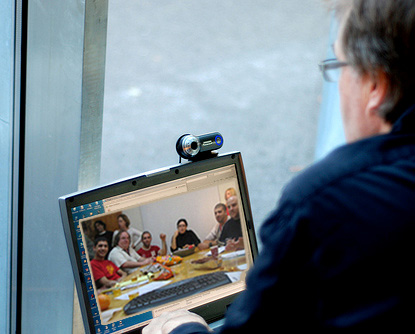 Sam McCarter – teacher, consultant and OUP author – considers the practicalities and benefits of teaching from a distance via videoconferencing.
Sam McCarter – teacher, consultant and OUP author – considers the practicalities and benefits of teaching from a distance via videoconferencing.
The problem was one of distance. I am an ESP teacher who is based in London, a couple of hundred miles away from the students and only able to deliver a face to face session once per month. The students were a group of postgraduate L2 doctors in a hospital in the northwest of England. The simple solution was videoconferencing.
The practical side
The equipment consists of two TVs or computer monitors with cameras sitting on top. The box with the camera acts as a receiver and transmitter of data over the phone line. When a connection is made, the students telephone a ‘videoconferencing’ number and the connection is almost instant. The classroom has to be laid out to achieve the best picture: as far as possible not directly at the window, the curtains pulled, and the camera zoomed in at both ends. The teacher sees the whole class, but can zoom in and out at any time to one student or a pair. You need to train one or more of the students to be able to use the remote at the other end.
Is the equipment reliable?
The answer is yes. As with any technology, there have been glitches, but without wishing to tempt fate, they have all been minor: forgetting to switch the camera on, having the TV on the wrong channel and having one of the leads in the wrong socket. But once the system is set up, as long as you don’t touch anything, then it seems to work well. There is a troubleshooter at the supplier that you can telephone who can establish a link to your videoconference to diagnose any problems. One very practical administrator had a neat solution to leads getting mixed up: she photographed the back of the TV for future reference!
What makes teaching communication skills to postgraduate doctors by videoconferencing effective?
Teaching communication skills in medicine by videoconferencing to a group of postgraduate L2 doctors is not as daunting as it seems. There are, of course, challenges; not least among them being the fact that as a teacher you are not physically there. As this does not appear to be a common facility yet in this field, there is no one to tell you what to do. Furthermore, to the students, you appear to be looking down as you are looking at the screen, not the camera. For the students, as the camera is taking in the whole class, this is not an issue. There is also a time delay which means there is an overlap with speaking between the teacher and students, but with time this is easy to manage.
But there are many upsides. Students take to it more quickly than you might think. There is always someone who needs to be in charge of receiving and distributing materials to the class – there is always someone who is willing to be in charge. As there is no white or black board for the teacher to write on, students have to concentrate for the two hour period, which certainly helps their listening skills!
Teaching methodology – trial and error
But how do you do pair or group work? From the point of view of the students there is no difference between this and being in the classroom with the teacher. But from the teacher’s viewpoint, there is one distinct advantage afforded by the microphone. The microphone is basically flat and triangular. If you put it between two students with the rest of the class ‘behind’ the microphone then you only hear the two students. The same applies to groups. Finding out how this worked was an accident. In one session, the microphone was at the front of a long table and the students behind the microphone could not be heard. That was how I learned how to do pair work.
Does videoconferencing affect teaching?
Yes, it improves it. It is necessary to be that little bit extra prepared. You need to email the material for the session in advance. Another upside is that it increases the students’ confidence. Students are often initially shy of speaking to the television or to colleagues with the TV watching, but just as students are initially reticent with a video camera in the room, this soon disappears. You notice this when a new student is introduced into the class and the other students take everything in their stride – almost with a swagger.
As videoconferencing becomes more common, and with holograms supposedly on the way, why not use it more for teaching students ‘off-site’ or even interviewing prospective students?


[…] prep work, and think about alternative lesson plans if (and when) tech glitches slow things down. Teaching from a Distance via Videoconferencing echoes this mindset of an improvement in teaching methods. You really do need to be a little more […]